Berita & analisis pasar
Tetap selangkah lebih maju di pasar dengan wawasan ahli, berita, dan analisis teknikal untuk memandu keputusan trading Anda.

Most traders understand EA portfolio balance through the lens of traditional risk management — controlling position sizes, diversifying currency pairs, or limiting exposure per trade.
But in automated trading, balance is about deliberately constructing a portfolio where different strategies complement each other, measuring their collective performance, and actively managing the mix based on those measurements.
The goal is to create a “book” of EAs that can help diversify performance over time, even when individual strategies hit rough patches.
A diversified mix of EAs across timeframes and assets can, in some cases, reduce reliance on any single strategy. This approach reduces dependency on any single EA’s performance, smooths your overall equity curve, and builds resilience across changing market conditions.
It’s about running the right mix, identifying gaps in your coverage, and viewing your automated trading operation as an integrated whole rather than a collection of independent systems.
Basic Evaluation Metrics – Your Start Point
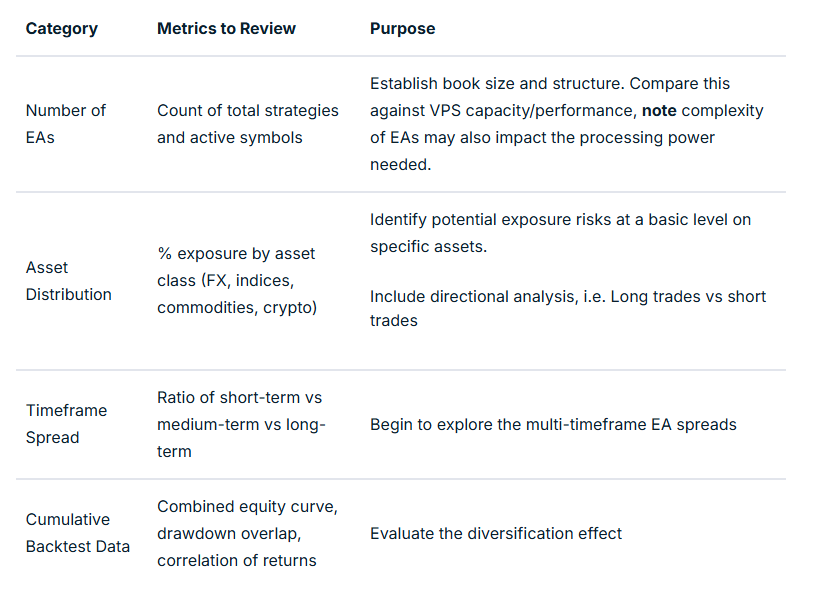
Temporal (timeframe) Balancing
When combined, a timeframe balance (even on the same model and instrument) can help flatten equity swings.
For example, a losing phase in a fast-acting M15 EA can often coincide with a profitable run in an H4 trend model.
Combining this with some market regime and sessional analysis can be beneficial.
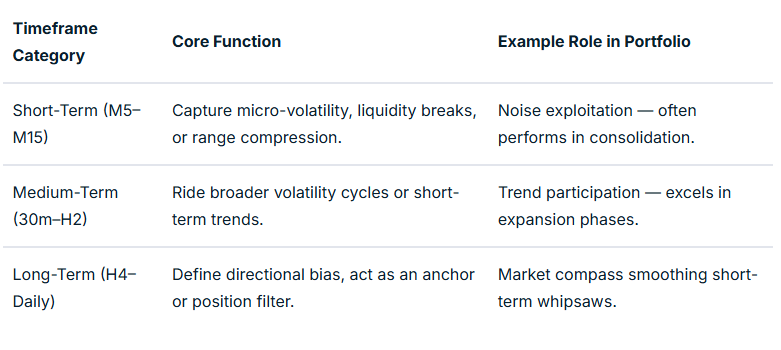
Asset Balance: Managing Systemic Correlation Risk
Running five different EAs on USDJPY might feel diversified if each uses different entry logic, even though they share the same systemic market driver.
But in an EA context, correlation measurement is not necessarily between prices, but between EA returns (equity changes) relating to specific strategies in specific market conditions.
Two EAs on the same symbol might use completely different logic and thus have near-zero correlation.
Conversely, two EAs on a different symbol may feel as though they should offer some balance, but if highly correlated in specific market conditions may not achieve your balancing aim.
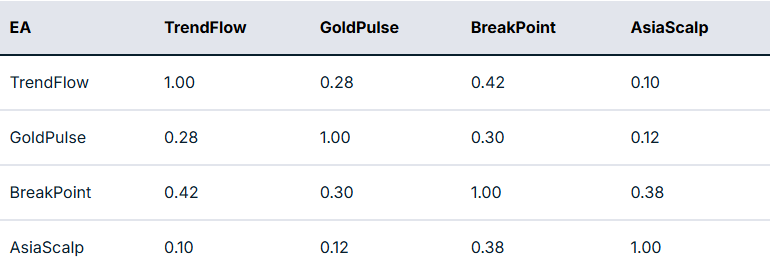
In practical terms, the next step is to take this measurement and map it to potential actionable interventions.
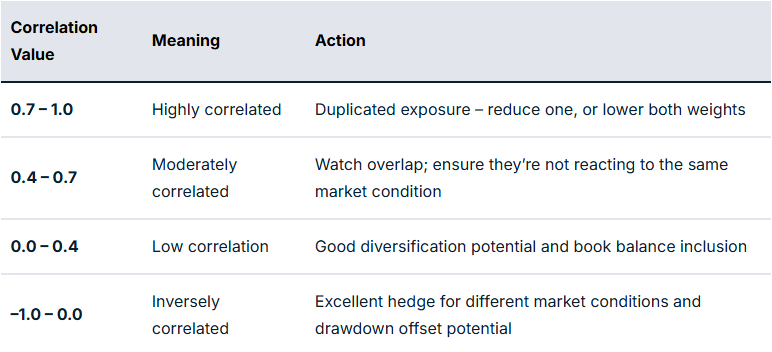
For example, if you have a EURUSD Trend EA and a GBPUSD Breakout EA with a correlation of 0.85, they are behaving like twins in performance related to specific market circumstances. And so you may want to limit exposure to some degree if you are finding that there are many relationships like this.
However, if your gold mean reversion EA correlates 0.25 compared to the rest of your book, this may offer some balance through reducing portfolio drawdown overlap.
Directional and Sentiment Balance
Markets are commonly described as risk-on or risk-off. This bias at any particular time is very likely to impact EA performance, dependent on how well balanced you are to deal with each scenario.
You may have heard the old market cliché of “up the staircase and down the elevator shaft” to describe how prices may move in alternative directions. It does appear that optimisation for each direction, rather than EAs that trade long and short, may offer better outcomes as two separate EAs rather than one catch-all.
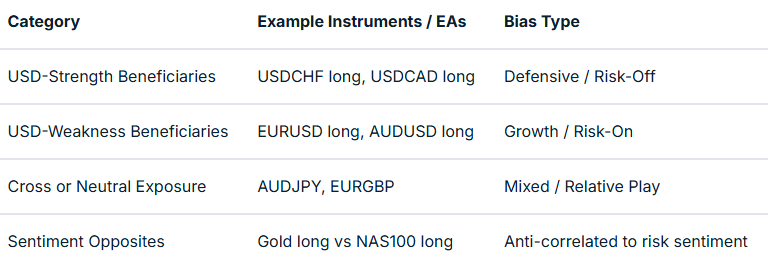
Market Regime and Volatility Balance
Trend and volatility states can have a profound impact on price action, whether as part of a discretionary or EA trading system. Much of this has a direct relationship to time of day, including the nature of individual sessions.
We have a market regime filter that incorporates trend and volatility factors in many EAs to account for this. This can be mapped and tested on a backtest and in a live environment to give evidence of strategy suitability for specific market conditions.
For example, mean reversion strategies may work well in the Asian session but less so in strongly trending markets and the higher volatility of the early part of the US session.
As part of balancing, you are asking questions as to whether you actually have EA strategies suited to different market regimes in place, or are you using these together to optimise book performance?
The table below summarises such an approach of regime vs market mapping:
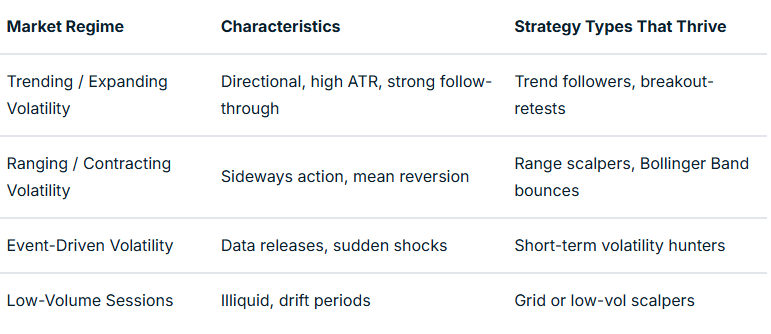
Multi-Level Analysis: From Composition to Interaction
Once your book is structured, the challenge is to turn it into something workable. An additional layer of refinement that turns theory and measurement into something meaningful in action is where any difference will be made.
This “closing the circle” is based on evidence and a true understanding of how your EAs are behaving together. It is the step that takes you to the point where automation can begin to move to the next level.
Mapping relationships with robust and detailed performance evaluation will take time to provide evidence that these are actually making a difference in meeting balancing aims.
To really excel, you should have systems in place that allow ongoing evaluation of the approaches you are using and advise of refinements that may improve things over time.
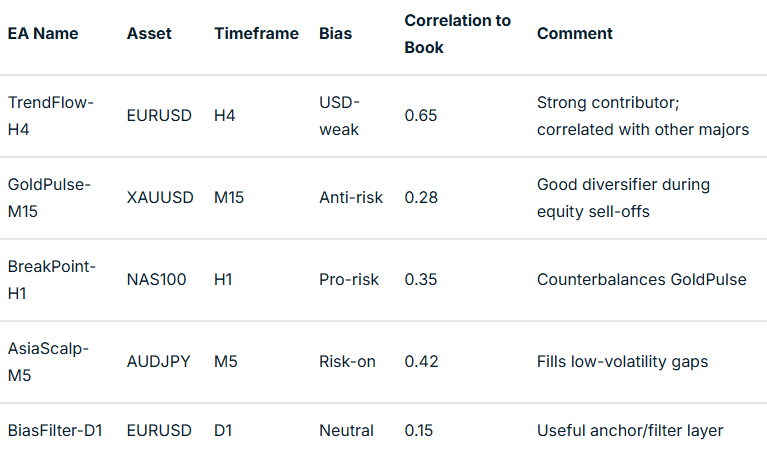
What Next? – Implementing Balance in Practice
Theory must ultimately translate into an executable EA book. A plan of action with landmarks to show progress and maintain motivation is crucial in this approach.
Defining classification tags, setting risk weights, and building monitoring dashboards are all worth consideration.
Advanced EA traders could also consider a supervisory ‘Sentinel’ EA, or ‘mothership’ approach, to enable or disable EAs dynamically based on underlying market metrics and external information integrated into EA coding decision-making.
Final Thoughts
A balanced EA portfolio is not generated by accident; it is well-thought-out, evidence-based and a continuously developing architecture. It is designed to offer improved risk management across your EA portfolio and improved trading outcomes.
Your process begins with mapping your existing strategies by number, asset, and timeframe, then expands into analysing correlations, directional bias, and volatility regimes.
When you reach the stage where one EA’s drawdown is another’s opportunity, you are no longer simply trading models but managing a system of EA systems. To finish, ask yourself the question, “Could this approach contribute to improved outcomes over time?”. If your answer is “yes,” then your mission is clear.
If you are interested in learning more about adding EAs to your trading toolbox, join the new GO EA Programme (coming soon) by contacting [email protected].
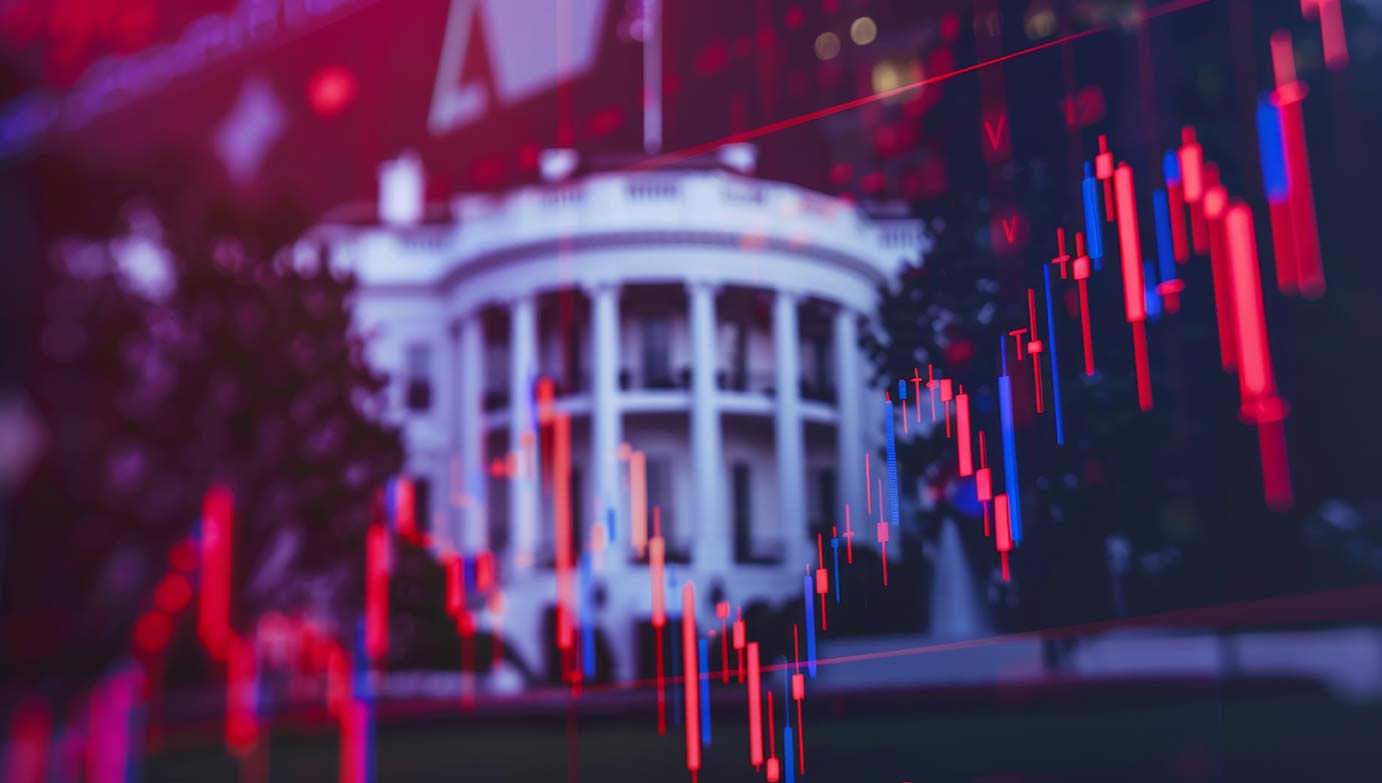

Join us for a special Inner Circle event as we examine the real-time market responses to the 2024 US Presidential Election results. We will explore market volatility and opportunities as reactions unfold across various asset classes. We will be hosting four live sessions throughout the day, led by our Head of Client Education and Senior Analyst, Mike Smith.
This is a valuable opportunity to observe, learn, and engage as we analyse chart movements, sentiment shifts, and technical setups in response to breaking election news. Session Schedule: 12:30 PM AEDT – US Polls Close & Early Asian Market Response 3:30 PM AEDT – Early Results & Key State Updates 6:30 PM AEDT – Preliminary Picture & European Open 9:30 PM AEDT – Fuller Market Picture & US Pre-Market Response Register now Whether you are an experienced trader or simply interested in the market's impact, you will gain valuable insights into how professional analysts assess and respond to significant events.


First – let us just say that as we suspected the AUD jolted all over the place on the release of the May CPI – the read was much stronger than consensus and the fallout from the read ongoing. But, and it’s a but, we predicted the AUD’s initial bullish reaction was counted by once again point to the fact parts of the monthly read can be explained away by changes made in May 2023. With that trade taken care of – we need to look to how things might transpire over the next period.
And that means digging through the monthly read for what matters and what doesn’t and thus start to assess an environment where the ‘frighten hawk’ that is the RBA moves on rates. May CPI 4.0% year on year – highest read since November 2023 So where are we? The non-seasonally adjusted monthly CPI indicator for May 2024 came in at 4.0% year-on-year smashing market consensus 3.8%, marking the highest rate since November 2023, the third consecutive monthly rise and marking 5 months since inflation was on a downward trajectory.
This jump needs to be put into context too April 2024 CPI was 3.6% year on year, the trough of 3.4% year on year observed from December to February feels like a distant memory. However as we mentioned above the market has found reason to back track on its initial bullishness most likely due to the month-over-month CPI in May 2024 decreased by -0.1% aligning with the 'seasonal average' of -0.1% since 2017. Compare that to the +0.7% month on month increase in April 2024, well above the seasonal average of +0.3%.
However the RBA doesn’t use headline CPI seasonally adjusted or not – it cares about core inflation which strips out the top and bottom 15%. And that means looking at trimmed mean CPI. The trimmed mean CPI, spiked to 4.4% year on year, also the highest reading since November 2023.
This marks a significant reacceleration from the 3.8% year on year low in January and the 4.1% year on year rate seen last month. As has been the case for most of 2024 goods inflation has remained steady holding around 3.3% year on year. The issue is services inflation which has surged to 4.8% year on year.
Another part of the inflation ‘story’ as to why inflation is so high has been global supply. However, the data has proven this to be false. Tradables (inflation that has international exposure) although rebounding in May to 1.6% from 1.1% is well below current inflation issues.
Non-tradables (domestic only facing inflation) remains well above target at 5.2% in May from 5.0% in April. This is a domestic-led spending issue and why the RBA is in play. Key Date: 31 July Second quarter CPI is out July 31 – as mentioned in Part 1 there is still some inputs that will be released in the coming 4 weeks that will shift expectation and consensus.
But in the main the consensus read now are pretty close to the final reads. The headline CPI is now expected to rise by 1.0% quarter on quarter (range 0.7% - 1.2) and 3.9% year on year (range 3.6% to 4.1%), above the RBA's May 2024 Statement on Monetary Policy (SOMP) forecast of 3.8% but possibly ‘tolerable’ but only just. A caveat to this figure is fuel price expectations for June, which sits at a decline of -1% month on month, which would subtract approximately ~4 basis points from the headline CPI.
But we digress as the trimmed mean consensus forecasts however are a concern and might not be tolerable for the RBA. Consensus forecasts for trimmed mean sits at 1.0% quarter on quarter (range 0.8 to 1.1%) and for a year on year increase of 3.9% year on year rise (range: 3.7% to 4.1%) also above the RBA's forecast of 3.8% year on year. Any slip into 4% on the trimmed mean figure and Augst 6 will be green lit.
The trade So how to position for the coming 5 weeks ahead of the August 6 meeting. Firstly understand that consensus amongst the economic world is the August meeting has a 35% risk of seeing a hike. The market is stronger at 45% - however it was as high as 61% at the peak of the bullishness post the inflation drop.
We should also point out that pre-June 5 the pricing in the market was for cuts not hikes. Showing just how fast and hard the interbank and bond markets have swung around. We also need to return to Governor Bullock's hawkish June press conference where the Board considered a rate hike and did not entertain a rate cut.
We also pointed out that every time the Board has added this sentence to the statement: The Board remains resolute in its determination to return inflation to target and will do what is necessary to achieve that outcome. It has seen a rise in the preceding meeting. We believe this give the upside potential more impetus and that will positively push the AUD higher over the coming weeks something we think is not fully factored into trading to date.
Then there are the other asset classes. Hikes complicates the outlook for equities, particularly as inflation remains sticky, especially in the services. Thus which sectors and areas of the equity market sure we be on the look to for signs of stress?
A prolong period of weakness in domestic trading conditions and the likely rise of frugal consumer behaviour will present challenging earnings for first half of fiscal year 2025 for discretionary and service sector stocks. Couple this with evidence of a slowdown in housing activity, material handling, product and construction stock are also likely to face pressure in early FY25. Need to also address Banks – which have been one of the best trades in FY24 with CBA leading the pack here, the question that remains however is that bank price growth in FY24 has been due to rate cut expectations and optimistic credit-quality risks.
This explains the elevated bank trading multiples. Weakening housing activity, will likely see investors questioning multiples of this nature in the near future. Trading the inflation story over the coming 5 weeks will be fascinating.


The basics: We are in the final weeks of the 2024 US presidential election. But what exactly are US citizens voting for and when will it actually take place? A US election always takes place on the first Tuesday of November – that means that for this year Tuesday, 5 November 2024, is when the election will be held, with the swearing of the next president of the United States of America taking place in the first week of January 2025 and will serve a 4-year term with the next election due in November 2028 for a swearing in in January 2029.
The electoral mechanics of a US election The President is not the candidate that gains the highest number of votes - known as the popular vote, just ask Hilary Cliton or Al Gore about this fact. The President is the candidate who wins the most ‘Electoral Colleges’. Each of the 50 US states and territories has a certain amount of electoral college votes allocated to it.
These votes are partly based on population densities and partly based on historical norms. The total number of electoral colleges across the country is 538 and thus the winner needs to gain 270 or more electoral college votes to win the Oval Office. Here is ‘Electoral College Map’ – each one of the numbers in each State is how many electoral college votes that State is allocated.
This is where it gets interesting, all but two states have a winner takes all rule. So even if the voting in Pennsylvania for example was 49.9% to 50.1% - the higher candidate would take all 19 votes for that State. There are two States that have a ‘split’ these being Maine and Nebraska.
As you can see in the map, these States have a split colour, in these two States some of the Electoral College votes can go to the lower voted candidate. However if there is a majority win all seats will go to the winner. These two have influenced elections in the past, however they are not expected to be in play this election.
The map currently shows five different scenarios. Those States that are solid towards one party or the other. Such as California (Democrats), and Texas (Republican).
Those States that are leaning towards one part of the other such as Colorado (Democrats) and Florida (Republican). Then there are those States that are the “Keys” to each election, the States that flip known as Swing States or battleground States. These have changed slightly over the years.
For example, the State of Ohio used to be known as the keystone State as every election up until 2012 which every party candidate Ohio voted for, won the oval office. It has now changed and is a lock for the Republican party. On the flipside States like Arizona and Nevada used to be locks for the Republican party; now they are swing States.
In 2024 there are 7 Swing States we see as the Keys to the election with one being the Keystone. They are: Wisconsin, Michigan, North Carolina, Georgia, Arizona, Nevada and the Keystone State of Pennsylvania. As things stand – Harris has solid and leaning State votes of 240, Trump has solid and leaning State votes of 225.
The seven Swing states have 93 so a combination of these will be needed for the candidate to cross the magical 270 mark. The Candidates Running as the Republican Party nominee is former president Donald Trump. He smashed his rivals in the primaries with a whopping majority and has been the presumptive nominee really since losing the 2020 election.
His vice-presidential running mate is Ohio senator JD Vance and is one of the youngest VP candidates in decades. Running as the Democrat nominee is current Vice-President Kamala Harris. Her road to the nominee has been unconventional as she joined the race after President Joe Biden dropped out and with no other Democrats standing against her no primaries were conducted.
Her vice-presidential running mate is Minnesota Governor Tim Walz, one of the oldest VP choices in decades although not as old as Trump himself. The Capitol The Oval Office is not the only thing up for grab on November 5, and although all of the attention will be on who wins the presidency. Congress which consists of both the House of Representatives and Senate will be up for grabs.
In the House of Representatives, all 435 seats are up for election. Currently the House is controlled by the Republicans, so a Trump Presidency with a Republican House would mean laws and spending directions would be easier to pass if the House status quo remained. But history shows that the house tends to swing every two years and having won the house in the Midterms the Republicans would be nervous of history repeating.
In the Senate 34 seats are being contested. There are 100 seats in the Senate rotating every 6 years. The Democrats currently control the Senate 51 seat to 49 and it's likely to also be hotly contested come November 5 and like the House anything is possible.
Trading the Day We think 2024 is likely to be similar to 2020 where the true result wasn’t known for several days. As the polls show 2024 is going to be one of the closest elections since WWII all votes will need to be counted before the winner is declared. We will be closely watching the seven Swing States for any signs one candidate is doing better than the other as this may provide a clearer picture of just how everything could play out.
But with postal votes and early voting slips in places like Michigan and Pennsylvania being counted last on the day they are likely to drag out the timeframes. We will also be watching key updates such as exit polls. The likes of Pennsylvania, North Carolina and Georgia have previously hit the newswire around 11am AEDT.
In 2016 these States moved in Trump’s favour and famously saw the betting agencies wiping their markets for several minutes before returning with Trump a favourite over Clinton having been outside odds all campaign. At around 2pm AEDT Midwest Central States will start to declare keep these times in your diaries. Watch for movements in DXY.
The dollar basket in the 2016 election was volatile as a Trump presidency was seen as an ‘unknown’ however very quickly after the event it was bid up as his policies and market friendly mantra lead to strong inflows. As he is a “known known” in 2024 this may not be as big a mover as 2016. However, it’s likely the USD will shift higher any perceived good ‘Trump news’.
Be aware of false dawns. All elections have false dawns with pre-emptive calls, biased interpretations, early ballot boxes showing big swings to one candidate due to small vote numbers. The list is long.
These are trader traps, remember the election will not be over inside the Australian business day as West Coast States only close as we finish the day. Take your time to do your research with reputable news outlets tuned in to players like Bloomberg, Politico, CNBC, 538.com and Silver Bullet. International media stations like the BBC and our own ABC are likely to be impartial and news only focused.
Over the coming weeks leading into the November 5 election, we will be here to give you as much information as we can as to what is moving markets from the US election 2024 with this as our dedicated landing page. (link or whatever you guys want). So welcome to trading the US Presidential Election with GO Markets.


Over the past 3 months Nvidia has moved through ranges that some stocks don’t do in years, in some cases decades. Having lost over 35 per cent in the June to August sell off, it quickly bounced over 40 per cent in the preceding 20 days once it hit its August low as we build positions ahead of its results. These results delivered Nvidia style numbers with three figure growth on the sales, net profit and earnings lines but this did not appease the market, seeing it fall 22 per cent in a little over 8 days.
Which brings us to now – a new 16 per cent drive as Nivida reports it’s struggling to meet demands and that the AI revolution is translating faster than even it expected. This got us thinking – Where are we right “Now” in the AU players? Thus, it’s time to dive into the drivers for the Nvidia and Co.
AI players. Supersonic As mentioned, Nvidia’s results have been astonishing – and it still has time to do a US$50 billion buyback. It collected the award for becoming the world’s largest company in the shortest timeframe in the post-WWII era, think about that for one second – that’s faster than Amazon, Microsoft, Apple, Google, Shell, BP, ExxonMobil, TV players of the 60s and 70s.
So the question is how does it keep its speed and trajectory? Well that comes from what some are calling the ‘supersonic’ scalers. These are the players like Google, Amazon, Meta and Microsoft that are the users and providers of the AI revolution.
These are the players that have spent hundreds billions thus far on the third digital revolution. Let us once again put that into perspective, the amount of spending is (inflation adjusted) the same as what was spent during the 1960’s on mainframe computing and the 1990’s distribution of fibre-optics. So we have now seen that level of spending in AI the next step is ‘usage’ and that is the inflection point we find ourselves at.
Currently AI is mainly used to train foundational models and chatbots – which is fine but not long-term financially stable. It needs to move into things like productions – that is producing models for corporate clients that forecast, streamline and increase productivity. This is the ‘Grail’ This immediately raises the bigger question for now – can this Grail be achieved?
The Voices To answer that – let us present some arguments from some of AI’s largest “Voices” On the AI potential and the possibility of a profound and rapid technological revolution, Sam Altman, CEO of OpenAI, has claimed that AI represents the "biggest, best, and most important of all technology revolutions," and predicts that AI will become increasingly integrated into all aspects of life. This reflects a belief in AI's far-reaching influence over time. The never subtle McKinsey and Co. has projected that generative AI could eventually contribute up to $8 trillion to the global economy annually.
This figure underscores the massive economic potential of AI. The huge caveat: McKinsey's predictions are never real-world tested and inevitably fall flat in the market. This kind of money is what makes AI so attractive to players in Venture Capital.
For the VC watchers out there the one that is catching everyone’s attention is VC accelerator Y Combinator which is fully embracing the technology. Just to put Y Combinator into context, according to Jared Heyman’s Rebel Fund, if anyone had invested in every Y Combinator deal since 2005 (which would have been impossible just to let you know), the average annual return would have been 176%, even after accounting for dilution. Furthermore to the VC story - AI has accounted for over 40 per cent of new unicorns (startups valued at $1 billion or more) in the first half of 2024, and 60 per cent of the increase in VC-backed valuations.
So far in 2024, U.S. unicorn valuations have grown by $162 billion, largely driven by AI’s rapid expansion, according to Pitchbook data. So the Voices certainly believe it can be achieved. But is this a good thing?
The Good, the Bad and the Ugly AI is advancing at such a rapid pace that existing performance benchmarks, such as reading comprehension, image classification and advanced maths, are becoming outdated, necessitating the creation of new standards. This reflects the fast-moving nature of AI progress. For example, look at the success of AlphaFold, an AI-driven algorithm that accurately predicts protein structures.
Some see this as one of the most important achievements in AI’s short history and underscores AI’s transformative impact on science, particularly in fields like biology and healthcare. This is the Good. Then there is the 165-page paper titled "Situational Awareness" by Aschenbrenner which has predicted that by 2030, AI will achieve superintelligence and create a $1 trillion industry.
Also, a positive, but will consume 20 per cent of the U.S. power supply. These incredible predictions emphasise the enormous scale of AI and the impact it will have on industry, infrastructure and people. The latest Google study found that generative AI could significantly improve workforce productivity.
The study suggests that roughly 80 per cent of jobs could see at least 10 per cent of tasks completed twice as fast due to AI, which has implications for industries such as call centres, coding, and professional writing. This highlights AI's capacity to streamline tasks and enhance efficiency across various fields. However it also raises the massive concern around job security, job satisfaction and the socio-economic divide as the majority of those affected by AI ‘productivity’ are in mid to low scales.
Then we come to Elon Musk’s new AI startup, xAI, which raised $6 billion at a valuation of $24 billion this year. The company is planning to build the world’s largest supercomputer in Tennessee to support AI training and inference. This all sounds economically and financially exciting but it has a darker side.
These are the kinds of AI ventures that have seen ‘deep-fake’ creations. For example Musk himself shared a deep-fake video of Vice President Kamala Harris. This is the ugly side of AI and reflects the broader cultural and ethical issues surrounding AI-generated content.
Furthermore – we should always be forecasting both the good and the bad for investment opportunities. These issues are already attracting regulations and compliance responses. How impactful will these be?
And will it halt the AI driven share price appreciation? It is a very real and present issue. Where does this leave us?
The share price future of Nvidia and Co is clearly dependent on the longer-term achievement of the AI revolution. As shown, the supersonic players in technology and venture capital are betting big on AI, with predictions that it will reshape the global economy, industries, and even basic societal structures. However, there is still uncertainty about the exact timeline for these changes and how accurately the market is pricing in AI's potential.
The AI ecosystem is moving at breakneck speed, with new developments outpacing benchmarks and productivity gains reshaping jobs, but whether all these projections that range from trillion-dollar economies to superintelligence materialises remains to be seen. Thus – for now – Nvidia and Co’s recent roller-coaster trading looks set to continue.


We have been discussing Sahms’ law for the last few weeks. This is the regression indicator that signals the possibility of recession. For those that can't remember, Sahms' recession indicator is when the three-month moving average of the unemployment rate has risen by more than 0.5 per cent from the previous 12 month low.
Every time this has happened since 1950 the US has entered a recession. Which brings us to last Friday’s non-farm payroll (NFP). NFP August jobs report revealed that total nonfarm payrolls grew by just 142,000, while private sector job growth amounted to a meagre 118,000.
That is the lowest read since COVID and both figures fell well short of consensus expectations. Even more concerning, revisions to June and July payrolls subtracted a combined 86,000 jobs, further underscoring the weakness in the labour market. That is on top of the 816,000 downward revisions of the January through May figures which saw the NFP overestimating the monthly employment figures by 69,000.
The next piece of the puzzle – a piece that backs the Sahms’ law puzzle is the three-month average for private sector job growth has now fallen below 100,000 per month, a pace that typically signals the onset of a recession.. However some are pointing to the fact that the unemployment rate ticked down slightly from 4.3 per cent to 4.2 per cent in August as a mixed signal and that maybe things aren’t as bad as the headlines. However this modest improvement was largely due to rounding, as the unrounded rate was effectively unchanged (4.22 per cent in August vs. 4.25 per cent in July).
This followed an earlier increase in unemployment, which had been trending higher over the past few months. The rise in the unemployment rate, combined with slowing job growth, indicates that the labour market is likely to weaken further unless the Fed moves to ease policy – which is why we are asking – has the Fed dropped the ball by not moving already? Let’s explore that further Data from the Job Openings and Labor Turnover Survey (JOLTS) shows that firms are hiring at the slowest rate in a decade, outside of the pandemic period.
Job openings fell to 7.673 million in July, which was significantly faster than expected and brought the ratio of job openings to unemployed persons to 1.07-to-1, down from the elevated levels seen during the pandemic. This decline in job openings suggests that the labour market is normalising, but it also raises the risk of a sharper increase in unemployment in the coming months as the ratio inverts. It's not only the multitude of employment indicators flashing risk.
Other indicators reinforce the case for concern. Take the auto sales numbers, which fell below expectations, with an annualised sales rate of 15.1 million vehicles, suggesting there is now a slowdown in consumer spending. The decline in auto sales historically spreads to weaker production and employment in the auto industry, as companies adjust staffing levels in response to reduced demand.
Meanwhile, mortgage applications for new home purchases remain subdued despite a drop in mortgage rates over the last four months on rate cut expectations. The lacklustre performance in both the auto and housing markets adds to the broader picture of economic weakness. The signs are pretty clear- the slowdown is on and as the Fed weighs its options ahead of the September meeting – the final piece of the puzzle is coming inflation.
It must be said that inflation remains a key focus. Core Consumer Price Index (CPI) inflation is expected to rise by just 0.2 per cent month-on-month in August, reinforcing the view that inflation has slowed considerably, but year on year CPI is still above the Fed 2 per cent target. Inflationary pressures are easing and the greater risk to the Fed's mandate appears to be the labour market rather than inflation, but it could be the moderator on those calls for the Fed to go hard when it starts cutting.
We need to watch categories like medical services and airfares as these are ones we need to see bigger falls in the rates of price growth and could influence the Fed's decision-making. But again, the overall trend suggests inflation is no longer the primary concern. Similarly, the Producer Price Index (PPI) is expected to show a modest increase of 0.2% month-over-month, further indicating that inflationary pressures are tapering off.
Jobless claims data will also be closely watched in the coming weeks. Continuing claims are expected to rebound after an unexpected drop, driven in part by a temporary decline in claims in Puerto Rico. Any significant rise in jobless claims, particularly initial claims, could signal a shift towards more active layoffs.
Can they catch the ball? All the data mentioned highlight our concerns about the trajectory of the U.S. economy. There are clear signs of a substantial slowdown and growing risk of recession.
Thus the question now is can the Fed catch slowdown before it turns into a recession? The answer is muddled as the Federal Reserve's response to the weakening outlook remains uncertain. The base case is for the Fed to initiate a series of rate cuts in the coming months.
Currently, projections indicate that the Fed may cut rates by 50 basis points (bp) in September followed by a smaller 25 bp cuts over the proceeding meetings. However, the pace and magnitude of these cuts remain open to adjustment, depending on the evolving economic conditions. While this is the view of the market, the Fed is not as united as this – for example: Federal Reserve Governor Christopher Waller has expressed a more measured approach.
In his September 6, 2024 speech, Waller emphasised that he prefers to see more data before endorsing larger rate cuts of 50 bp rather than the more conservative 25 bp. He signalled that the Federal Open Market Committee (FOMC) needs to remain flexible and should adjust its actions based on new data rather than adhering to preconceived timelines for rate cuts. The issue with this view is that data is retrospective and by the time it's presented it would be too late to catch the slowdown.
He expressed willingness to support larger cuts if the data shows further deterioration, drawing parallels to his previous support for front-loading rate hikes when inflation surged in 2022. But again – the argument against this stance is it could be too little too late. Waller’s remarks suggest that the Fed could adopt a cautious approach in September, potentially starting with a 25 bp cut but leaving room for larger cuts if economic data continues to weaken at either the November or December meeting.
So could the Fed drop the ball? We think the word to use here is “fumble”. There are clear signs of disagreements around, size, speed and effects of cuts, which may cause them to fumble the response in the interim, over the medium term it will align, whether they catch or drop the ball – time will tell.
In short – we are in for a volatile period in FX, already the USD has been falling on rate fundamentals, but rallies on recession fears. The drive to safe havens over risk plays will be a strong theme in the coming period and will likely override any interest rate differential trade plays that present. It is going to be an interesting period culminating in the US election in November, thus be ready to be nimble and accept swings that seem to go against traditional trading theories.


We will do a deep dive into how to trade the upcoming US Federal Reserve meeting on Wednesday but for now we need to address the Fed and others from an Australian traders perspective as it is one of 3 plays we need to be mindful of. 1. Hard or Soft – Can we stick the landing? All central banks across the developed world are doing summersaults, with a one and half twist to land their respective economies with a soft landing.
And this is increasingly seeing them align towards coordinated easing – barring the RBA more on that later. The debate between soft and hard landings in the global economy is accelerating. For example, traders have begun to notice that there is a switch in trade from the previously held trade of bad economic data that was often seen as good for risk assets, as it increased the likelihood of monetary easing.
To the now, poor data is also being traded as negative for risk, reflecting growing fears that economic weakness could be deeper and more prolonged than anticipated. We have highlighted this point through the US employment data and the slowing numbers in GDP. Equity markets clearly believe they will stick the landing with record all -time high trading in the DOW, S&P and most other major bourses including the ASX 200.
But they have yet to fully account for the potential downside risks of a hard landing scenario. In fact, equities have a bigger divergence that could spell trouble if central banks get it wrong as it is really only a small group of high-performing sectors or stocks that are driving gains, while many others lag. This narrow leadership, combined with elevated valuations, raises concerns about the market's vulnerability should the hard landing scenario materialise.
This brings us to Thursday’s Federal Reserve meeting – it will cut the expectations for a 25-basis point cut at the upcoming September meeting sits at 42 percent the bigger 50-basis point cut sits at 62 per cent. This has led to increased debate around market positioning and sector rotation. The Fed’s recent communications have largely endorsed the beginning of an easing cycle at a slow pace.
But that hasn’t stopped traders putting in an upward repricing - the bull steepening of the yield curve, particularly led by short-term yields, as markets anticipate rate cuts. This steepening trend, which began in earnest in late June, is significant because it reflects a growing belief that the most acute phase of the economic slowdown, and the associated recession risk, may be over. Take the US 2-year and 10-year yield curve which has been inverted.
Traditionally, an inverted yield curve signals a looming recession, but the recent return to a more normal curve suggests that the period of waiting for a slowdown and/or recession may have passed, and markets are now pricing in the economic consequences of monetary easing. Historically, during periods of bull steepening, certain defensive sectors such as Healthcare, Utilities, Banks, and Staples have outperformed, as investors shift towards sectors that offer stability and reliability in times of economic uncertainty, but that hasn’t happened – suggesting a gap is forming. Looking closer to home - the typical sectoral performance associated with yield curve steepening has only partially played out.
Just have a look at the Tech sector, it has significantly outperformed this year, a divergence from its usual underperformance during such periods. This divergence is largely due to the impressive growth execution couple that with their larger capitalisations in this cycle has made them a substitute for the quality growth traditionally offered by Healthcare. Looking forward, should the yield curve move from bull steepening to bull flattening (where the long end of the curve leads the decline), leading sectors are expected to shift.
In a bull flattening trade, sectors such as Real Estate and Materials typically emerge as leaders, creating the potential for broader equity market gains. This scenario is currently the most plausible case for broadening equity returns and driving further upside in the market index. 2. Commodities: Mind the thud While financial markets are pricing in the possibility of a soft landing, commodity markets are facing a much more severe test of the hard landing so hard it might be considered a ‘thud’.
The cost curves for key Aussie commodities, such as Iron Ore and Metallurgical Coal, are being battered by soft global demand and oversupply dynamics particularly out of China. These cost curves are being tested as commodity prices struggle to find support amid concerns over an economic slowdown. This is certainly the scenario BHP and Rio are seeing and have factored this into their forward guidance numbers.
Then we look at global commodities - oil inventories have reached levels typically associated with recessions, further signalling the market's concern over weakening demand and OPEC’s recent communiques suggesting it will halt its planned increases in output. We also have a scenario not seen in the modern era, a China story that isn’t working. China’s economic policies are under intense scrutiny, and the country’s growth trajectory will significantly impact global demand for key commodities in the coming year.
The negative price signals in the commodities space stand in sharp contrast to the more optimistic outlook being priced into equity markets. While equities suggest a soft landing is still the base case, commodities are flashing red with alarm as price weakness implying deeper demand concerns and thus issues around growth. This divergence raises the risk of a sharper reversal in positioning, particularly in resource-linked equities.
The caveat to this is the ongoing capital constraints on supply, combined with the potential easing of demand concerns as monetary policy softens, could set the stage for a recovery in certain commodity markets. If this was to play out, broad exposure to large-cap Energy stocks, particularly in Oil and Uranium, as well as to large-cap diversified Materials and Gold could be beneficial, as these sectors are well-positioned to benefit from any eventual recovery in global demand. 3. RBA’s Easing Path – When not If The Reserve Bank of Australia (RBA) continues to chart its own path.
It’s cautious approach that prioritises inflation risks has been the core principle of RBA Governor Michele Bullock. And despite mounting expectations for a faster easing cycle, the RBA has so far resisted pressure to cut rates aggressively stating that controlling inflation is far more important than short term growth concerns. Investors are divided on how quickly the RBA will move to ease policy.
While the central bank has maintained a patient stance, market expectations are pricing in a full rate cut by February. The consensus view is that the RBA will ultimately follow the lead of other central banks and cut rates sooner than currently forecast, with some expecting the easing cycle to begin well before the RBA’s projected May 2025 timeline. But whenever it starts – all are of the same view, once they start it will signal a solid period of cuts.
The consensus is that come December 2025 – the cash rate will be 3 percent not the current 4.35 per cent we have. The RBA’s decision-making will come down to the economic landing all are facing. Should a hard landing materialise, the RBA may be forced to cut rates faster to support the domestic economy.
However, if a soft landing prevails, there is every incentive for the RBA to remain behind its global peers in cutting rates. This approach (which is the current one taken by the RBA) would help support the AUD. It would also help in reducing the inflationary pressures from imported goods, while also allowing the labour market to cool and consumption to weaken, preventing a rapid reacceleration of inflation once policy is eased.
For equity markets, the RBA’s cautious easing profile suggests a prolonged period of below-trend growth. This would delay the cyclical uplift in earnings that is needed to justify current market valuations. As a result, it can explain why the ASX keeps hitting resistance at around 8100 points, there is no catalyst to push it higher.
While the easing cycle will eventually provide a tailwind for equity valuations, the current environment of slow growth and cautious monetary policy implies that significant market gains are unlikely until later in the cycle.

